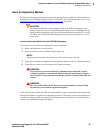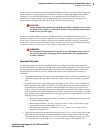
2
Installing Hardware for the G700 Media Gateway and S8300 Media Server
Installation and Cabling
Installation and Upgrades for G700 and S8300 93
December 2003
A ground block is available for use when multiple G700 Media Gateways are being installed. The ground
block, intended for rack mounting, has ten terminals available for terminating Supplementary Ground
Conductors. Up to ten G700 Media Gateways can be grounded at the block installed close to the
equipment (on a rack) and then a single ground conductor can be routed from the same block to an
approved ground. If the ground block is to be used, it must be ordered separately.
!
DANGER:
Failure to install both grounds will void the Product Safety certifications (UL and the
CE Mark) on the product, as well as allow a hazard to be present that could result in
death or severe personal injury.
Because of unreliable earthing concerns in Finland and Norway, the G700 Media Gateway must be
installed in a restricted access location. A restricted access location is defined as access that can be gained
by only Service Personnel or Customers who have been instructed about the reasons for the restricted
access and any safety precautions that must be taken. In these cases, access to the G700 Media Gateway
is gained by the use of a tool (such as a lock and key) or other means of security.
!
WARNING:
For Installations in Finland and Norway, the Avaya G700 Media Gateway relies on
two ground connections (mains plug with an earth contact, and a Supplementary
Ground Conductor).
Approved Grounds
An approved ground is the closest acceptable medium for grounding the building entrance protector,
entrance cable shield, or a single-point ground of electronic telephony equipment. If more than one type
of approved ground is available on the premises, the grounds must be bonded together as required in
Section 250-81 of the NEC for the US or per the local electrical code regulations in the country of
installation.
• Grounded Building Steel: The metal frame of the building where it is effectively grounded by one
of the following grounds: acceptable metallic water pipe, concrete encased ground, or a ground
ring.
• Acceptable Water Pipe: A metal underground water pipe, at least 1/2-in. (1.3 cm) in diameter, in
direct contact with the earth for at least 10 ft. (3m). The pipe must be electrically continuous (or
made electrically continuous by bonding around insulated joints, plastic pipe, or plastic water
meters) to the point where the protector ground wire connects. A metallic underground water pipe
must be supplemented by the metal frame of the building, a concrete-encased ground, or a ground
ring. If these grounds are not available, the water pipe ground can be supplemented by one of the
following types of grounds:
— Other local metal underground systems or structures - Local underground structures such
as tanks and piping systems.
— Rod and pipe electrodes - A 5/8-in. (1.6 cm) solid rod or 3/4-in. (2 cm) conduit or pipe
electrode driven to a minimum depth of 8 ft. (2.4 m).
— Plate electrodes - Must have a minimum of 2 sq. ft. (0.185 sq. m) of metallic surface
exposed to the exterior soil.
• Concrete Encased Ground: An electrode encased by at least 2 in. (5.1 cm) of concrete and located
within and near the bottom of a concrete foundation or footing in direct contact with the earth.
The electrode must be at least 20 ft. (6.1 m) of one or more steel reinforcing bars or rods, 1/2-in.
(1.3 cm) in diameter, or at least 20 ft. (6.1 m) of bare solid copper, 4 AWG (26mm
2
) wire.


















